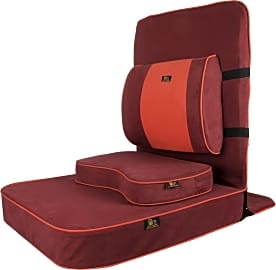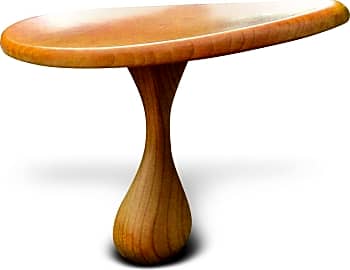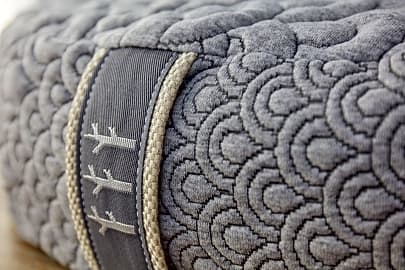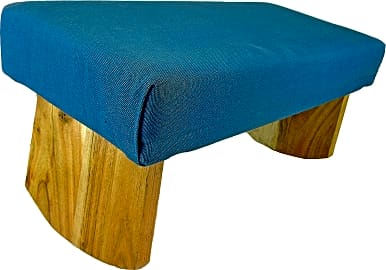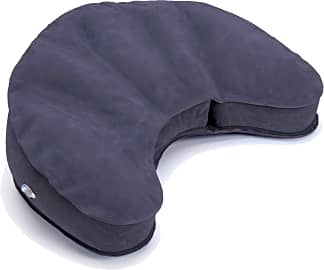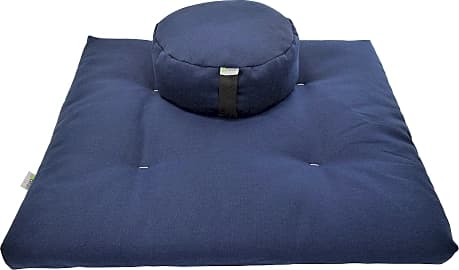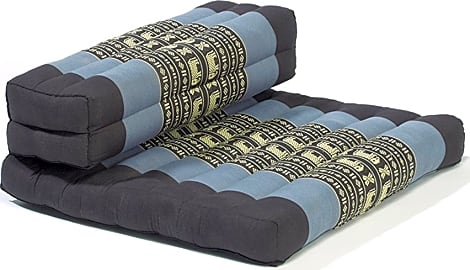The 10 Best Meditation Cushions

This wiki has been updated 45 times since it was first published in September of 2015. Practiced in various forms by cultures around the world for centuries, you can approach meditation as a mystical doorway that leads to life's greatest mysteries, or just as a practical tool to help you cope with day-to-day stress and anxiety. Whether you're an experienced practitioner or a curious amateur, our selections for this category are sure to have something for you. When users buy our independently chosen editorial selections, we may earn commissions to help fund the Wiki.
Editor's Notes
March 11, 2020:
During this round of updates, we removed the Trevida Organic Zafu due to availability issues, as well as the Bean Products Zafu – noting that it was already included in our rankings as part of the Bean Products Cushion Set. We also eliminated the YogaAccessories Round Zafu – because we simply had too many zafus, and the Gaiam Zabuton – noting that by nature zabutons aren’t especially useful without a sitting cushion to crown them, as in the case of the Bean Products Cushion Set and Samadhi Cushions Gomdem Set. Lastly, in order to make room for new additions, we removed the Waterglider International Zafu Crescent, feeling that the Mobile Meditator Inflatable already presented a serviceable crescent-zafu option.
Our new set of rankings are comprised of 50% new offerings, including the Samadhi Cushions Gomdem Set, a bulky, rectangular, foam cushion sat atop of a cotton-stuffed zabuton, a style popularized by Shambhala International’s founding teacher Chogyam Trungpa Rinpoche in the sixties; the Alexia Zen Chair, a pricey option with an ergonomic design that lends itself well to long, crossed-legged samatha sessions; and the Still Sitting Nomad, a portable option designed by Norwegian architect Asmund Skar that works well for kneeling practices.
Different people like different styles of meditation cushion. If you’re studying a specific lineage or with an instructor that endorses certain kinds of practice, then the decision might already be made for you. Or, if you’re just a meditation-curious newbie who read some interesting things about mindfulness lately, it might be on you to personally decide what you find the most comfortable. Typically, it takes significant time spent on any given cushion to decide whether or not you like it, so settling on the perfect cushion for you personally is a journey that can take some time. While we unfortunately won’t be able to walk through that journey with you, we have provided a brief list of some of the cushions out there, to give you a bit of a starting point if you need one.
Zabuton: This is the rectangular (or, sometimes square) cushion that sits below your sitting cushion. They vary in size, but are usually somewhere in the neighborhood of a square meter. They’re especially nice for when you’re practicing on hard floors that don’t offer much relief for your ankles, feet and shins, but even in carpeted rooms they can be quite helpful – as they help establish a physical container for your practice space. They can be purchased separately, or in a set like the Bean Products Cushion Set and Samadhi Cushions Gomdem Set.
Zafu: Chances are, this is the cushion that comes to mind when you first think of meditation cushions. Zafu’s are round, low to the ground, and typically filled with buckwheat. Though they can be used for kneeling postures, you tend to think of half-lotus (loosely crossed legs) and full-lotus (pretzeled crossed legs) sitting positions when you think of zafus like the Brentwood Home Crystal Cove.
Crescent Zafu: This option’s quite similar to a zafu, only instead of round they’re crescent shaped, like a heavily shaded moon or a butter croissant. Though they offer you less space to spread out your hind parts, some cross-legged practitioners prefer crescent zafus because they allow you to position your ankles closer to your pelvis, which tends to help facilitate good upright posture. While these cushions are also traditionally filled with buckwheat, the Mobile Meditator Inflatable is a blow-up option that nomadic meditators will appreciate.
Gomdem: These shoe-box-sized cushions typically have a core comprised of a dense foam brick. Like Zafu’s they’re great for cross-legged practice, but they tend to be a bit taller, which can make a difference for larger users, as well as people who don’t bend so well. I have a lot of personal experience sitting on the Samadhi Cushions Gomdem Set, and can’t say enough good things about it. I highly recommend this option for experienced and beginner meditators alike.
Meditation Bench: While semantic purists will likely question whether offerings like these truly qualify as meditation cushions, in practice they share a unified purpose, and it's tough to have a conversation about one without discussing the other. Models like the Meditation Designs Bench are great for users who prefer to practice kneeling in the seize position, and the Simplysitting Handcrafted Bench and Still Sitting Nomad are two alternative options also well worth considering, as both benches boast beautiful and portable designs.
Why Use a Meditation Cushion (As Opposed to Sitting On The Floor)?
The point of all this being that a meditation cushion adds to the nirvana of any person's daily practice.
One of the goals of meditation is to achieve an inner-balance; a weightless flow that allows your mind and body to approach transcendence. This might explain why meditation usually takes place in a private setting, or in a place where peace and tranquility are the norm.
Anyone who meditates knows that a person's concentration can be disrupted by anything from an urge to sneeze to a passing siren. One of the most common forms of distraction is a lack of circulation, brought on by sitting in a lotus position (i.e., legs crossed, palms up) while placing one's weight upon the lower body.
The lotus position becomes more taxing the longer a meditation session continues. By using a cushion you can alleviate a certain level of discomfort while promoting blood flow throughout the central regions. On top of which, most high-quality meditation cushions come with a machine-washable liner. This means that you can place crushed potpourri or other fragrances on, in, or around your cushion, and then wash those fragrances clean, thereby avoiding any set-in stains or mildew.
Certain meditation cushions can be placed vertically along a wall to relieve any lumbar pressure throughout your lower-back. Other cushions are compact enough that you can use them as travel pillows, or as a headrest, assuming that you do any of your meditating while seated on a couch. The point of all this being that a meditation cushion adds to the nirvana of any person's daily practice. Modern Buddhists are known to use cushions as a way of heightening their flow.
Mindfulness 101: The Myriad Benefits of Meditation
Meditation has some truly remarkable benefits. For starters, meditation is proven to increase a person's focus and concentration, both of which are critical to developing superior problem-solving skills. Meditation has also been proven to reduce stress, while having a sustainable impact on cases of anxiety, high blood pressure, and depression.
Meditation has a positive effect on mnemonic abilities, while also promoting creativity and an ability to think outside the box.
Research shows that meditation causes a person to exhibit more patience, which, in turn, leads to better listening and more productive communication. Meditation leads to introspection and self-evaluation, along with increased levels of empathy and compassion. Meditation has a positive effect on mnemonic abilities, while also promoting creativity and an ability to think outside the box. Meditation leads to relaxation, helping people to overcome insomnia and several other sleep-deprivation disorders.
According to a study published by the Journal of Biobehavioral Medicine, people who meditate are prone to higher levels of immunity and an increased resistance to pain. What's more, various studies have concluded that prolonged periods of meditation can actually reduce cellular inflammation, thereby decreasing the risk of heart disease and several other circulatory disorders.
As if all of this isn't enough, meditation is free (short of the initial cost of learning how to practice). More to the point, meditation doesn't have any negative side effects. A consistent practice can have a positive impact your outlook, along with your health, and your quality of life.
A Brief History of Meditation
Meditation, which literally means "to think, contemplate, devise, or ponder," dates all the way back to the 6th Century, BCE. During its formative era meditation was cultivated among the Taoists in China, the Hindus in India, and early Buddhists throughout Nepal.
Around 1,000 BCE, meditation began to spread into various parts of Europe and Northern Africa.
Around 1,000 BCE, meditation began to spread into various parts of Europe and Northern Africa. Whereas the majority of organized religions had been built around looking outward to a God, meditation taught that spiritual enlightenment could only be attained from within. Chinese Buddhists, in particular, had commenced a new tradition based on "Zen," or deriving heightened states of being. Every meditating student was provided with a guru and a mantra. These mantras were usually a one-syllable sound that was meant to be chanted throughout one's routine.
By the 12th Century, meditation had become a widespread practice, with devotees extolling the virtues of this new-age technique. Mainstream religions including Judaism and Christianity continued to shun meditation as little more than an ego-driven form of prayer. Scientific data disagreed, however, with Victorian-era researchers documenting the wide range of benefits being reported by meditating subjects.
Meditation began to draw a worldwide audience during the 1970s, particularly after it attracted the attention of American intellectuals, including Ram Dass, the author of Be Here Now. Today, it is estimated that 18 million American adults practice some form of meditation. The unofficial capital of meditation - at least for Buddhists - is considered to be Nepal.



